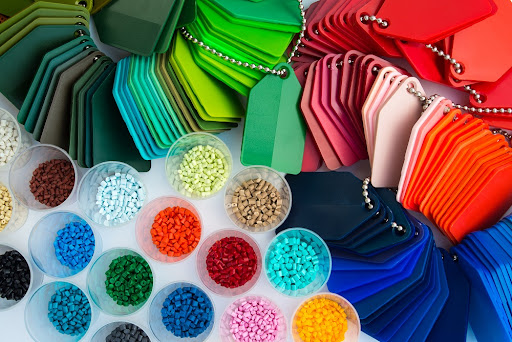
by Kandui Industries Pvt. Ltd. | Feb 3, 2025 | Color Masterbatch
Introduction:
White masterbatches are a class of essential additives that have found widespread use in various industries. As a versatile solution, they play a crucial role in enhancing the appearance, performance, and cost-effectiveness of plastic products. In this blog, we will explore the benefits and diverse applications of white masterbatch in different industries, highlighting its significance in the world of plastic manufacturing.
Improved Opacity and Whiteness:
One of the primary benefits of using white masterbatch is its ability to provide superior opacity and whiteness to plastic products. By incorporating high-quality titanium dioxide (TiO2) and other additives, white masterbatch ensures that the base polymer achieves an even and consistent white coloration. This is especially beneficial for applications where a pure, bright white appearance is desired, such as in packaging materials and consumer goods.
Cost-Effective Coloration:
White masterbatch offers a cost-effective means of achieving white coloration in plastics. By using masterbatches, manufacturers can avoid the need to stock various white pigments, reducing inventory costs and waste. Additionally, the accurate dosage and dispersion of white masterbatch in the base polymer ensure uniform color distribution, eliminating the risk of color variations during production.
UV Protection:
White masterbatch can be formulated to provide UV protection to plastic products. The titanium dioxide particles in the masterbatch scatter and absorb UV radiation, helping to shield the underlying plastic from harmful UV rays. This makes white masterbatch a suitable choice for outdoor applications where UV degradation can lead to color fading and reduced product lifespan.
Thermal Stability:
Incorporating white masterbatch into plastics enhances their thermal stability. The masterbatch acts as an effective thermal barrier, reducing heat absorption and improving the material’s resistance to temperature fluctuations. This property is advantageous for applications in the automotive and electronics industries, where products may be exposed to varying temperature conditions.
Wide Range of Applications:
White masterbatch finds applications across diverse industries. It is commonly used in the production of films, sheets, fibers, injection-molded parts, and extruded profiles. Industries such as packaging, textiles, automotive, construction, and household goods benefit from the versatility of white masterbatch in achieving desired product aesthetics and performance.
Easy Processing:
White masterbatch is designed to be compatible with various plastic resins, ensuring ease of processing during manufacturing. The masterbatch can be uniformly dispersed in the base polymer without affecting its processing characteristics, making it convenient for manufacturers to incorporate white coloration into their products seamlessly.
Conclusion:
White masterbatch is an indispensable additive that offers numerous benefits to the plastic manufacturing industry. Its ability to provide improved opacity and whiteness, cost-effective coloration, UV protection, thermal stability, and ease of processing makes it a preferred choice for a wide range of applications. From enhancing the appearance of packaging materials to ensuring product durability in outdoor environments, white masterbatch plays a vital role in delivering high-quality, visually appealing, and reliable plastic products across various industries. Manufacturers can harness the advantages of white masterbatch to create innovative solutions that meet the ever-evolving demands of consumers and industries alike.

by Kandui Industries Pvt. Ltd. | Jan 20, 2025 | Color Masterbatch, Masterbatches
Colour masterbatches, also known as colour concentrates, are additives used in the plastics industry to provide specific colours to plastic products. They are concentrated mixtures of pigments or dyes dispersed in a carrier resin.
Colour masterbatches are widely used in various plastic applications to achieve desired colours in products such as films, sheets, bottles, containers, toys, and many other plastic items. They offer a convenient way to incorporate colour into plastic formulations without the need for extensive colour mixing or direct addition of pigments.
The masterbatch is typically added to the base polymer during the manufacturing process. It is mixed with the base resin to achieve the desired colour and opacity. The concentration of the colour masterbatch added depends on the desired intensity of the colour and the transparency of the final product. Different grades and concentrations of colour masterbatches are available to meet specific application requirements.
Colour masterbatches offer several advantages, including consistent colour reproduction, improved dispersion of pigments, ease of handling and storage, and flexibility in adjusting the colour intensity. They also allow manufacturers to achieve a wide range of colours by using different combinations of pigments or dyes.
It’s important to note that colour masterbatches are available in various types and formulations, each suitable for different plastic materials and processing conditions. Manufacturers often provide a range of standard colours, but custom colour matching is also possible to meet specific colour requirements.
Overall, colour masterbatches play a crucial role in the plastic industry by providing an efficient and cost-effective solution to achieve consistent and vibrant colours in plastic products.

by Kandui Industries Pvt. Ltd. | Dec 23, 2024 | Color Masterbatch, Kolokan Masterbatch
Kolokan masterbatch is a specialized additive used in the plastic industry to add colour to plastic products. It offers several features that make it advantageous for colouring plastics.
Here Are The Top 10 Features Of Kolokan Masterbatch:
Precise Colour Matching:
Kolokan masterbatch is formulated to achieve precise and consistent colour matching, ensuring that the desired colour is achieved in the final product.
Uniform Dispersion:
The pigments or dyes in colour masterbatch are uniformly dispersed within the carrier resin. This results in even and consistent colour distribution throughout the plastic material, reducing the risk of streaks or blotches.
Ease of Use:
Colour masterbatch is easy to handle and incorporate into the plastic manufacturing process. It can be directly mixed with the base polymer resin, simplifying the coloration process.
Customization:
Manufacturers can work with suppliers to create custom colours to meet specific design or branding requirements. This customization allows for a wide range of colour options.
Cost-Effective:
Using Kolokan masterbatch can be more cost-effective than purchasing individual pigments or dyes in bulk. It minimizes material waste and reduces the need for extensive inventory of multiple pigment powders.
Consistency:
Kolokan masterbatch ensures colour consistency from one production batch to another, making it ideal for industries where uniformity is essential, such as automotive and consumer goods.
Compatibility:
Kolokan masterbatch is compatible with various plastic resins, including polyethylene (PE), polypropylene (PP), polyvinyl chloride (PVC), and more, making it versatile for different applications.
Stability:
The pigments used in Kolokan masterbatch are often selected for their stability, ensuring that the colour remains vibrant and resistant to fading or degradation over time.
Reduced Processing Time:
Incorporating colour masterbatch into the manufacturing process is faster and more efficient than measuring and mixing individual pigments. This can lead to shorter production times and increased productivity.
Enhanced Product Aesthetics:
Kolokan masterbatch allows manufacturers to achieve vibrant and eye-catching colours, improving the overall aesthetics and visual appeal of plastic products.
Overall, Kolokan masterbatch is a valuable tool for achieving consistent, customizable, and cost-effective coloration of plastic materials in various industries, from packaging and consumer goods to automotive and construction.

by Kandui Industries Pvt. Ltd. | Nov 18, 2024 | Color Masterbatch, Masterbatches
Engineering polymer colour masterbatch offers several advantages in various industries.
Here Are The Top Five Advantages:
Consistent Coloration:
Engineering polymer colour masterbatch ensures consistent and uniform coloration of plastic materials. This is essential for industries where colour consistency is crucial, such as automotive, consumer electronics, and packaging. The masterbatch contains pre-dispersed pigments or dyes, resulting in even colour distribution throughout the final product.
Ease of Use:
Using colour masterbatch simplifies the manufacturing process. Instead of handling and measuring individual pigment powders, manufacturers can directly add the masterbatch to the polymer resin. This streamlines production, reduces the risk of errors, and saves time and labor costs.
Cost-Effective:
Engineering polymer colour masterbatch can be more cost-effective than buying individual pigments in bulk. The pre-dispersed pigments in masterbatch form can be precisely dosed, minimizing waste and reducing material expenses. Additionally, it often requires less storage space than storing multiple pigment powders.
Customization:
Masterbatch allows for easy colour customization. Manufacturers can work with suppliers to create custom colours that meet specific design or branding requirements. This flexibility is valuable in industries where unique product aesthetics are a competitive advantage.
Improved Quality:
Using colour masterbatch can lead to higher product quality. Because the pigments are uniformly dispersed, there is less risk of streaking or uneven coloration in the final product. This consistency contributes to better overall product appearance and performance.
In summary, engineering polymer colour masterbatch simplifies the coloration process, enhances consistency, reduces costs, offers customization options, and contributes to higher product quality, making it a valuable choice for industries that require coloured plastic materials.

by Kandui Industries Pvt. Ltd. | Nov 4, 2024 | Color Masterbatch
Colour masterbatch is one of the common methods for colouring plastics, but whether it is the best way depends on your specific application and requirements. There are several ways to colour plastics, and the choice of method should consider factors such as cost, consistency, production volume, and the final appearance and properties of the plastic product.
Here Are Some Common Methods For Colouring Plastics:
Colour Masterbatch: Colour masterbatch is a concentrated mixture of pigments or dyes that are pre-dispersed in a carrier resin. This method offers good colour consistency, is easy to use, and is suitable for a wide range of plastic processing techniques like injection moulding, extrusion, and blow moulding. It’s commonly used for large production runs.
Dry Colour Mixing: In this method, dry pigment is added directly to the plastic resin during the processing stage. It is suitable for smaller production runs or when a wide range of colours is required. However, it may require more precise control to achieve consistent colour.
Liquid Colorants: Liquid colorants are dye-based colorants that are added to the polymer melt. They are suitable for applications that require transparent or translucent colours. Liquid colorants can be dosed more precisely but may not offer the same colour consistency as masterbatch.
Compounding: Compounding involves melt-blending the plastic resin with pigments and additives. It offers more control over the colour and properties of the final product, making it suitable for custom formulations. However, it’s a more complex and costly process.
In-Mould Colouring: In-mould colouring is a process where colour is added to the mould cavity before injection moulding. It’s suitable for products with intricate designs or multiple colours. However, it’s not as commonly used as masterbatch or other methods.
The choice of colouring method depends on your specific needs. Colour masterbatch is often favored for its ease of use, consistency, and cost-effectiveness for large production runs. However, if you need precise control over colour or have unique requirements, other methods like compounding or in-mould colouring might be more appropriate. Additionally, consider the compatibility of the colouring method with the type of plastic resin you are using, as different resins may require different colouring techniques.

by Kandui Industries Pvt. Ltd. | Mar 17, 2024 | Color Masterbatch, Masterbatches
Choosing the right black masterbatch depends on several factors related to the end-use application, performance requirements, and cost considerations. Here’s a guide to help you make the best choice:
1. Application Requirements
- Type of Polymer: Black masterbatches are specific to the type of polymer you’re processing, such as PP, PE, PET, ABS, etc. Ensure that the black masterbatch is compatible with the polymer used in your product.
- End Use: Determine whether the application is for outdoor or indoor use. Outdoor applications may require UV-stabilized black masterbatch to prevent fading or degradation due to sunlight exposure.
- Regulatory Requirements: If your product comes into contact with food or medical equipment, ensure the masterbatch complies with relevant regulations (FDA, EU food contact standards, etc.).
2. Carbon Black Content and Type
- Carbon Black Grade: Different grades of carbon black offer different levels of dispersion, opacity, and gloss. For example:
- High Jetness (High Tint): Provides a deep, rich black color but may cost more.
- General-Purpose Grades: More cost-effective but with lower performance for appearance-focused applications.
- Loading Level: A higher carbon black loading (15–50%) provides greater opacity, but it’s important to balance this with cost and processing conditions.
3. Dispersion Quality
- Uniform Dispersion: For applications where aesthetics and surface quality are critical (such as films or molded parts), choose a masterbatch with excellent dispersion characteristics to avoid streaking or poor color uniformity.
- Filler Content: Some masterbatches may contain fillers (such as calcium carbonate) that can affect properties like gloss, mechanical strength, and appearance. Ensure that these fillers align with your product requirements.
4. UV Resistance
- For outdoor applications, UV stability is crucial. Some black masterbatches come with UV stabilizers to protect the product from degradation due to prolonged sun exposure.
5. Processing Conditions
- Ensure that the black masterbatch can withstand the temperature range of your process. For instance, high-temperature applications (e.g., extrusion or injection molding) require a masterbatch that doesn’t degrade under heat.
6. Cost Considerations
- Price vs. Performance: Balance the cost of the masterbatch with the performance characteristics you need. Higher jetness and UV stability often come at a premium, so optimize based on the value it provides to your product.
- Dilution Ratio: Calculate the required dilution ratio for your polymer to avoid overusing masterbatch, which can lead to higher costs.
7. Sustainability & Additives
- Look for black masterbatches that align with any sustainability goals you may have. Some black masterbatches are made with recycled carbon black, which could contribute to an eco-friendly solution.
- Additives like antioxidants or thermal stabilizers may be necessary for certain products to ensure long-term durability.
By considering these factors, you’ll be better equipped to select the most suitable black masterbatch for your application.







